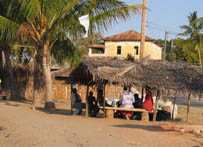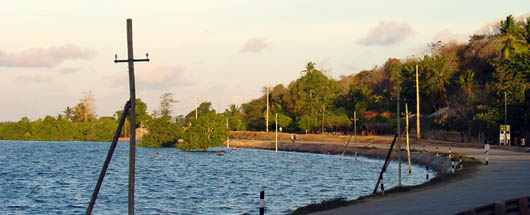Intro •
Eco2 & Lodging •
The Diving •
Site: The Monoliths •
Site: Crypto Mania •
Site: Namponda Corner •
Zanzibar •
Mikumi National Park •
Facts •
Still Life •
Moving Pix
P
Mtwara Province doesn’t take up much space in even the best of guide books of Tanzania. Apart from a few development NGO’s such as Danish School Project only a few tourists find their way to this region, though deep sea fishers and divers (and those who have to get as far away as possible from everything) are awakening to the challenge.

The local communities are poor and resources are scarce but if you’re willing to improvise, to take things as they come, you’re in for a great experience.
You can come a long way with a few selected phrases
in Kiswahili and a bit of understanding of the state of things.
Mtwara is the south eastern of Tanzania’s provinces, 40 kms north of
Mozambique. If you’ve ever heard of it, it might be due to its production of
cashew nuts (second largest producer in the world) or due to the exquisite
wood carvings of the Makonde Tribe, which are a world apart from the sloppy
work found in most places in Dar es Salaam or Zanibar.
The village of Mikindani is situated at the bottom of a natural, protected
bay – 10 degrees south of the Equator – and was once the entrance into
Africa in the quest for slaves, ivory, and cobber.
The Makonde Tribe were the indigenous population and protected themselves against slavery by filing their teeth sharp as needles and applying extensive tattoos.
By the 9th century Arabs controlled the area, and it has since then been subjected to sovereignty changes like that of Zanzibar and as much of Africa.
After the First World War the Germans surrendered the country to the U.K. who moved the whole caboodle to Mtwara – a small village 12 kms southeast of Mikindani with a better natural harbour that was capable of handling larger ships. Since then time has been standing still in Mikindani.

On a Monday in November 2005 we boarded a small Air Tanzanian flight in
Dar es Salaam and landed just 50 minutes later in Mtwara. The alternative
was about 23 hours of 4-wheel driving on mainly dirt roads and
crossing wobbly (if not missing) bridges.
The diving alone
makes the trip to Mikindani worth your while, but the whole area has a
pristine quality. There are still lots of places and species to
discover – both above as well as below the surface.
The
southern most border of the marine park is formed by Ruvuma River, which
also marks the border between Mozambique and Tanzania. A place well worth
a visit in its own right. And shame on you if you don’t catch a game
drive once you’re here.
In 1866 Dr. David Livingstone stayed in Mikindani for a fortnight before
he embarked on his third and final expedition to discover the source of
the Nile. Only his heart was returned – in a wooden box. We on the other
hand arrived at home safely – but left our hearts in Mikindani though not
in wooden boxes.

The inner bay at Mikindani at high tide a
